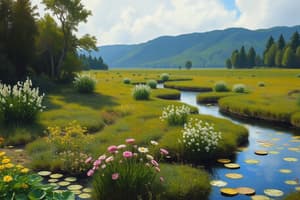Podcast
Questions and Answers
Primary Succession would most likely occur after which of the following?
Primary Succession would most likely occur after which of the following?
- Growth of plants after a forest is destroyed by fire
- Clearing and farming
- Forest-clearing
- A lava flow (correct)
What is one difference between primary and secondary succession?
What is one difference between primary and secondary succession?
Secondary succession begins on soil, while primary succession begins on a newly exposed surface.
A tropical rain forest may not return to its original climax community after which of the following?
A tropical rain forest may not return to its original climax community after which of the following?
- Lava flow
- Clearing and farming (correct)
- Forest fire
- Flood
An example of human-caused disturbance is?
An example of human-caused disturbance is?
Which of the following is likely to be a pioneer species?
Which of the following is likely to be a pioneer species?
What kind of natural disturbances help some forest communities?
What kind of natural disturbances help some forest communities?
Succession is possible because?
Succession is possible because?
Which of the following is an example of secondary succession?
Which of the following is an example of secondary succession?
Which of the following is not a likely component of soil formed during primary succession?
Which of the following is not a likely component of soil formed during primary succession?
What type of succession occurs after a volcano?
What type of succession occurs after a volcano?
A landslide causes part of a mountainside to fall away. In the years immediately following the landslide, the area will experience?
A landslide causes part of a mountainside to fall away. In the years immediately following the landslide, the area will experience?
An invasive species is also considered?
An invasive species is also considered?
Which of the following is a benefit of invasive species?
Which of the following is a benefit of invasive species?
What is an invasive species?
What is an invasive species?
Flashcards are hidden until you start studying
Study Notes
Primary and Secondary Succession
- Primary succession occurs on surfaces devoid of soil, such as after a lava flow or volcanic activity.
- Secondary succession starts in areas with existing soil and is triggered by disturbances like fires or landslides.
- Disturbances, both natural (e.g. floods, forest fires) and human-caused (e.g. forest-clearing), can reset ecological succession.
- A tropical rainforest may not revert to its original climax community after substantial clearing and farming.
- Pioneer species, such as lichen, are crucial for primary succession as they initiate the process of soil formation.
- Secondary succession can be exemplified by the growth of plants after a forest is destroyed by fire, utilizing the existing soil.
- During primary succession, soil composition lacks organic material from mature plants like shrubs and trees.
- New species in an ecosystem often outcompete existing ones, making the environment unsuitable for the previous dominant species.
- Invasive species, also known as exotic species, can often disrupt local ecosystems; however, some can provide benefits, such as the European Honey Bee in pollination.
- Invasive species are defined as non-native organisms that proliferate within a community and may alter the existing ecological dynamics significantly.
Studying That Suits You
Use AI to generate personalized quizzes and flashcards to suit your learning preferences.




